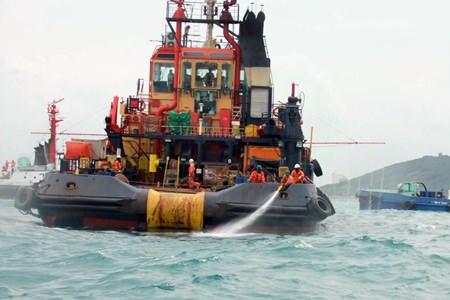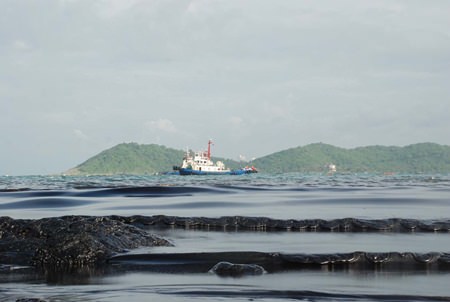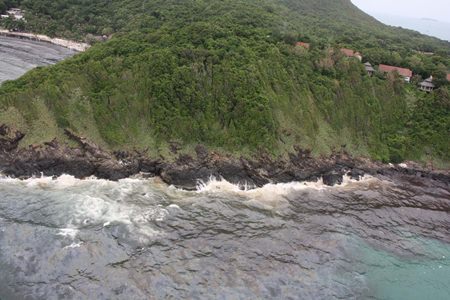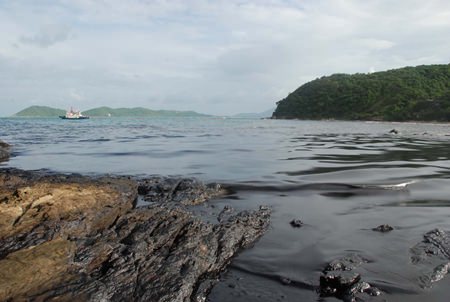
Cleanup workers
frantically fight a losing battle, trying to keep oil from ruining Ao
Prao beach in front of Le Vimarn Cottages & Spa on Samet Island. About
50 tons of crude oil spilled into the sea off Rayong province Saturday
morning, July 27, after a leak sprung in a pipeline operated by PTT
Global Chemical Plc, a subsidiary of state-owned oil and gas company PTT
Plc.
Patcharapol Panrak
PTT Global Chemical PCL pledged to clean up an oil spill that
closed Koh Samet’s Ao Prao Bay within three days, but public officials
warn that restoring the island’s white-sand beaches may take weeks.
About 600 PTT employees, Royal Thai Navy personnel and marine staffers
scrambled to contain and mop up nearly 5,000 liters of oil that washed
ashore on eight kilometers of western Koh Samet shoreline after a pipe
at the oil company’s offshore transfer station leaked, spilling about
50,000 liters of crude into Rayong Bay July 27.

An aerial view of the
spill on the day it happened, July 27.
Workers dressed in white jumpsuits armed with towels and rubber booms
fought a losing battle with the black waves as they washed ashore in
front of luxury vacation cottages and spas. Within hours, about a third
of the guests at affected hotels had canceled or left, according to
various media reports.
On July 29, Rayong Gov. Wichit Chatpaisit declared Koh Samet a
marine-disaster area and ordered the entire Ao Prao Bay closed to
tourists and boats. PTT Global Chemical CEO Anon Srisaengtaksin told a
press conference that the company would clean up the mess within three
days.
But Sumet Saithong, chief of the Laem Ya Samet Islands National Park,
told the media the same day he expected it would take at least 15 days
to restore the beach.
Navy officials moved quickly to contain the petroleum after it was
discovered. A flotilla of vessels from the navy, Marine Department and
IRPC Co. dropped booms around the V-shaped spill about 10 nautical miles
off the Maptaput Industrial Estate and Thailand Maritime Enforcement
Coordination Center Region 1 personnel also sprayed chemicals to break
up the slick.

Oil spill containment rigs
were brought in immediately, shown here on July 28 using chemicals to
dissolve the oil.
Strong winds that whipped up swells thwarted the effectiveness of the
booms, however, allowing a 300-meter-long stretch of oil to escape
containment. Thai authorities then hired planes from Singapore’s Oil
Spill Response Co., which arrived at U-Tapao-Pattaya International
Airport Monday.
By that evening, PTT and Navy officials claimed 95 percent of the oil
had been dissolved, although that news came too late for the pristine
beaches of Koh Samet.
The oil washing ashore was 30cm thick at some points and officials were
desperate to contain the damage to Ao Prao Bay, although traces of oil
started appearing in Kham Bay, also on the island’s western side. At
press time, Rayong authorities were bracing for impact, as the oil
reportedly was headed for Rayong’s famous Ban Phe Beach.
Most of Koh Samet’s hotels and resorts are on the eastern side of the
island and officials remained confident other parts of the island would
not be affected.

It was all too late for Ao
Prao Bay, as oil in some places as thick as 30cm washed up on shore.
The fishing industry, however, will not be so lucky. Fishermen reported
the smell of crude oil even where it couldn’t be seen.
Rattana Manprasith, director of the Eastern Marine Fisheries Research
and Development Center, said the agency planned to collect water samples
and check the behavior of marine life to determine the extent of the
damage.
Both public officials and area residents have already begun calling for
PTT to compensate the region for the spill. Rayong MP Sathit Pititaesa
on Monday demanded a full investigation and for PTT to establish a fund
to cover the cleanup and mitigation of the oil-spill damage.
Jaturas Iemworaniran, president of the Rayong Small Fishermen’s
Association, claimed marine resources and food sources already have been
destroyed by the spill and demanded that PTT take responsibility.
“This is not the first time that Rayong has faced these incidents with
affects and sloppy solutions,” Jaturas said. “Today, companies have used
chemicals to dissolve the oil into the sea. This will definitely destroy
the ecosystem in the long-term. Isn’t it time for a clear and concise
environmental solution strategy?”

The prevailing winds and
tides drove the oil slick headlong into western Koh Samet.

As dawn broke on July 29,
officials realized there was nothing they could do to stop the oil from
reaching Koh Samet.

Clean up crews work to clean
up the mess July 29 on Ao Prao Beach.







